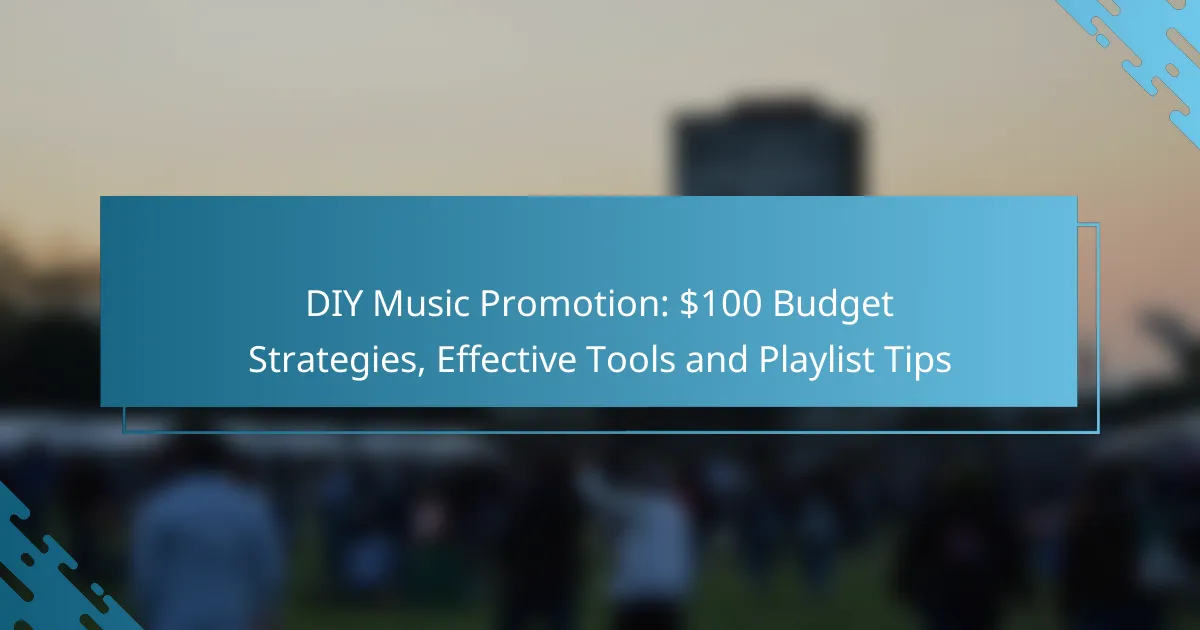Promoting your music on a $100 budget is entirely feasible with the right strategies and tools. By focusing on cost-effective methods such as social media engagement, email outreach, and playlist submissions, you can effectively expand your audience without breaking the bank. Leveraging curated playlists and utilizing efficient promotional tools will enhance your visibility and streamline your efforts, allowing you to concentrate on what you do best—making music.
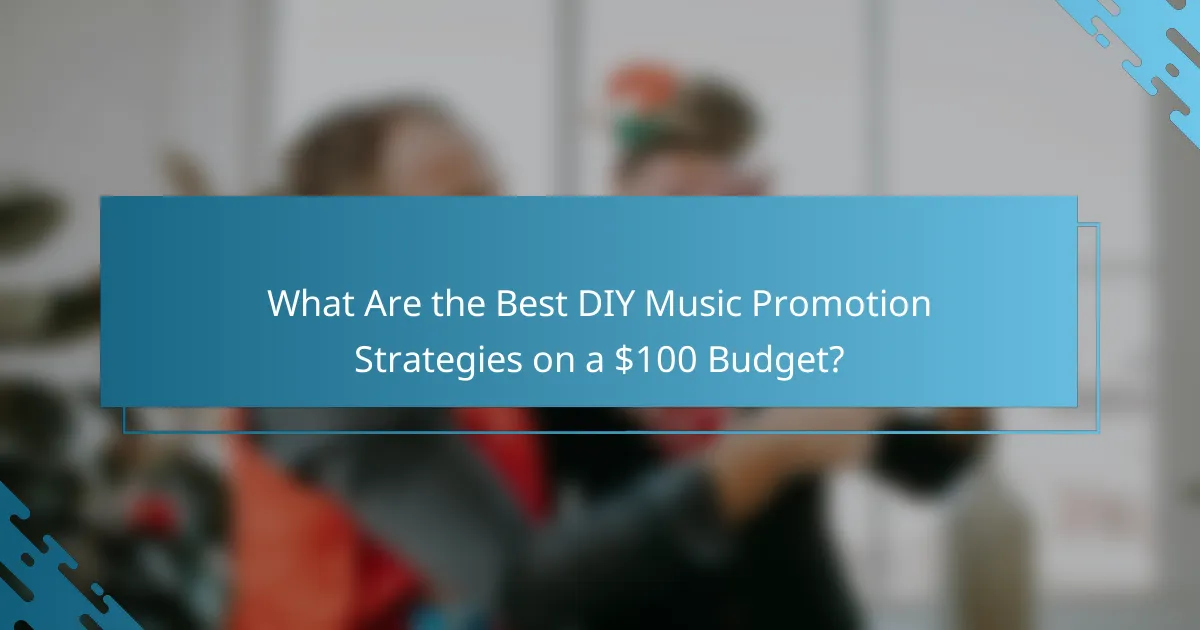
What Are the Best DIY Music Promotion Strategies on a $100 Budget?
Effective DIY music promotion on a $100 budget requires strategic allocation of resources to maximize reach and engagement. Focus on cost-effective methods that leverage social media, email, and collaborations to build your audience without overspending.
Social Media Advertising
Social media platforms like Facebook and Instagram offer targeted advertising options that can fit within a $100 budget. You can create ads that reach specific demographics, such as age, location, and music preferences, ensuring your music reaches the right audience.
Start by setting a clear objective for your ad campaign, whether it’s increasing streams, gaining followers, or promoting an event. Allocate your budget wisely, perhaps spending $5 to $10 per day over a week to test different ad formats and messages.
Targeted Email Campaigns
Email marketing remains a powerful tool for promoting music. Use platforms like Mailchimp or Sendinblue to create targeted campaigns that engage your existing fanbase and attract new listeners. With a budget of $100, you can often send thousands of emails, depending on the service you choose.
Build your email list by offering exclusive content or incentives, such as free downloads or early access to new releases. Craft compelling subject lines and content that resonates with your audience to improve open and click-through rates.
Utilizing Music Blogs
Getting featured on music blogs can significantly boost your visibility. Research blogs that align with your genre and reach out with a personalized pitch, including a link to your music and a brief bio. Many blogs accept submissions for free, making this a cost-effective strategy.
Consider creating a press kit that includes high-quality images, a biography, and links to your music. This professionalism can increase your chances of being featured and help you stand out in a crowded space.
Collaborating with Influencers
Partnering with social media influencers can expand your reach without a hefty price tag. Look for influencers in the music niche who resonate with your style and audience. Many are open to collaborations in exchange for free music or merchandise.
When approaching influencers, be clear about what you can offer and how it benefits them. A well-structured collaboration can lead to increased exposure and new fans, making it a worthwhile investment of your budget.
Creating Engaging Content
Content creation is essential for music promotion. Use your budget to produce high-quality visuals, such as music videos or promotional graphics, that capture attention. Engaging content can be shared across social media and email campaigns to keep your audience interested.
Consider using tools like Canva for graphic design or platforms like TikTok to create short, engaging videos that showcase your music. Regularly posting content helps maintain engagement and keeps your audience updated on your latest releases and events.

How Can I Effectively Use Playlists for Promotion?
Using playlists for music promotion can significantly enhance your visibility and listener engagement. By strategically submitting to curated playlists, creating your own, and engaging with curators, you can effectively reach new audiences and boost your music’s exposure.
Submit to Curated Playlists
Submitting your tracks to curated playlists is a powerful way to gain exposure. Research playlists that align with your genre and audience, and follow their submission guidelines closely. Many playlists are managed by influencers or music enthusiasts who curate songs based on specific themes or moods.
Consider using platforms like SubmitHub or PlaylistPush, which connect artists with playlist curators. When submitting, include a brief, compelling pitch about your music and why it fits the playlist. Aim for a personalized approach rather than a generic message.
Create Your Own Playlists
Creating your own playlists allows you to showcase your music alongside tracks from other artists you admire or that fit a specific vibe. This not only promotes your songs but also builds a community around shared musical tastes. Use platforms like Spotify or Apple Music to curate and share your playlists.
Incorporate a mix of your tracks and popular songs to attract listeners. Promote your playlists on social media and encourage followers to share them. Regularly update your playlists to keep them fresh and engaging, which can help retain listener interest.
Engage with Playlist Curators
Building relationships with playlist curators can enhance your chances of being featured. Follow them on social media, engage with their content, and express genuine appreciation for their work. This can create a rapport that may lead to future collaborations or features.
When reaching out, be respectful of their time and preferences. A concise, polite message introducing yourself and your music can go a long way. Remember to follow up, but avoid being overly persistent; striking a balance is key to maintaining a positive relationship.
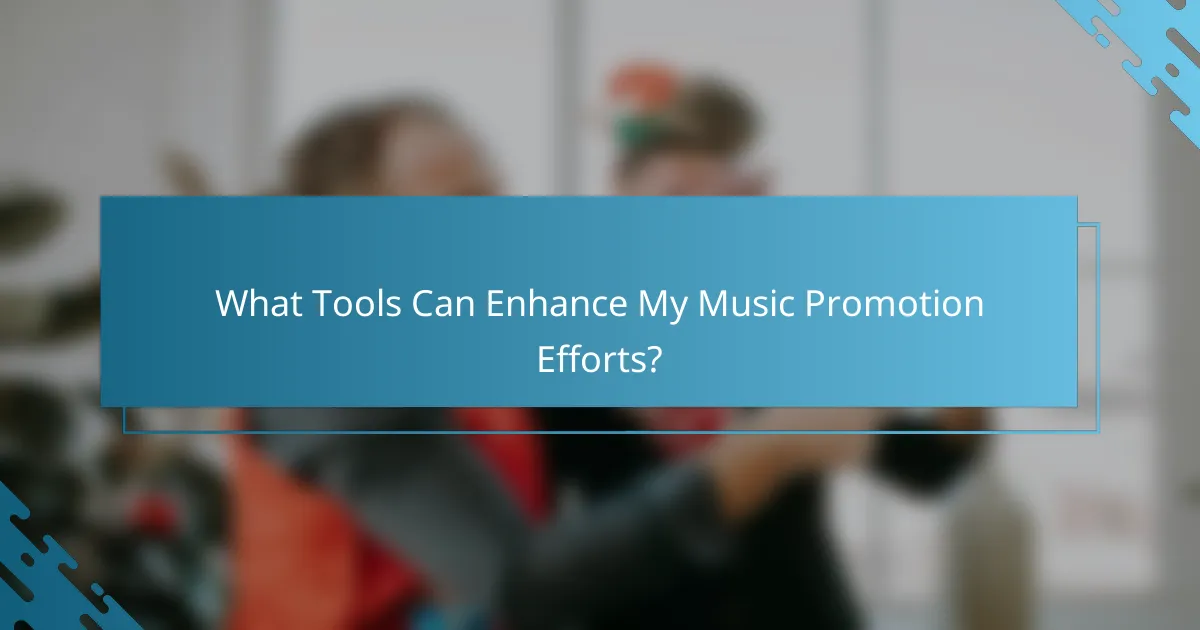
What Tools Can Enhance My Music Promotion Efforts?
Utilizing the right tools can significantly improve your music promotion strategies. Effective tools streamline your efforts, allowing you to focus on creating music while reaching your audience efficiently.
Canva for Visuals
Canva is a user-friendly graphic design tool that helps you create eye-catching visuals for your music promotion. You can design album covers, social media posts, and promotional materials without needing advanced design skills.
To get started, choose a template that fits your brand, customize it with your images and text, and download your designs in various formats. This tool is particularly useful for maintaining a consistent visual identity across platforms.
Hootsuite for Scheduling
Hootsuite is a social media management platform that allows you to schedule posts across multiple networks simultaneously. This tool is essential for maintaining an active online presence without needing to post in real-time.
Set up a content calendar to plan your posts ahead of time, and use Hootsuite’s analytics to track engagement. Aim to post at optimal times based on your audience’s activity, which can improve visibility and interaction rates.
SubmitHub for Playlist Placement
SubmitHub is a platform that connects artists with playlist curators, making it easier to get your music featured on popular playlists. This can significantly boost your exposure and reach new listeners.
When using SubmitHub, carefully select curators whose playlists align with your genre. Be prepared to pay a small fee for submissions, and always personalize your messages to increase your chances of acceptance. Aim for a balance between quality submissions and your budget to maximize your promotional efforts.
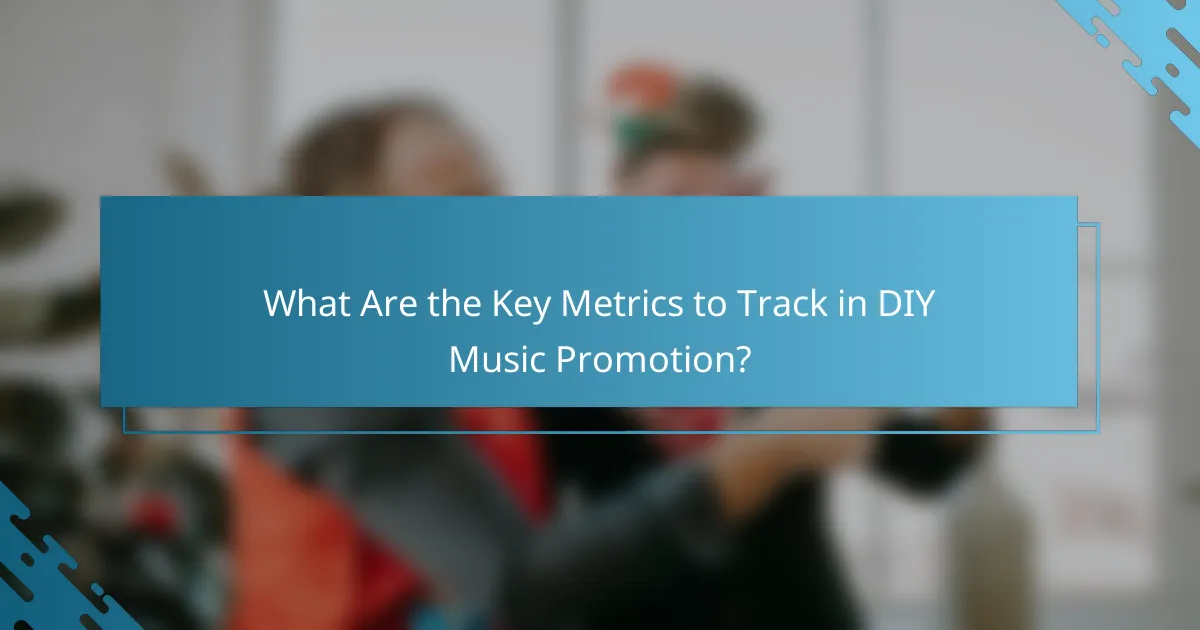
What Are the Key Metrics to Track in DIY Music Promotion?
Key metrics in DIY music promotion include streaming numbers, social media engagement, and email open rates. Tracking these metrics helps artists understand their audience, measure the effectiveness of their promotional efforts, and make informed decisions to enhance their reach.
Streaming Numbers
Streaming numbers indicate how often your music is played on platforms like Spotify, Apple Music, and YouTube. Monitoring these figures helps you gauge the popularity of your tracks and identify which songs resonate most with listeners.
Consider setting specific goals for your streaming numbers, such as reaching a certain number of plays within a month. Aiming for a growth rate of 10-20% can be a reasonable target for emerging artists. Regularly analyze your data to adjust your promotional strategies accordingly.
Social Media Engagement
Social media engagement measures how actively your audience interacts with your content on platforms like Instagram, Facebook, and Twitter. Key indicators include likes, shares, comments, and follower growth, which reflect your ability to connect with fans.
To improve engagement, focus on creating compelling content that encourages interaction, such as polls, behind-the-scenes videos, or live Q&A sessions. Aim for a consistent posting schedule and engage with your audience by responding to comments and messages to foster a loyal community.
Email Open Rates
Email open rates reveal the percentage of recipients who open your promotional emails. This metric is crucial for understanding how effectively your subject lines and content capture interest.
A good open rate typically ranges from 15-25% for the music industry. To enhance this metric, segment your email list based on listener preferences and personalize your messages. Avoid spammy language in your subject lines and ensure your emails provide value, such as exclusive content or special offers.
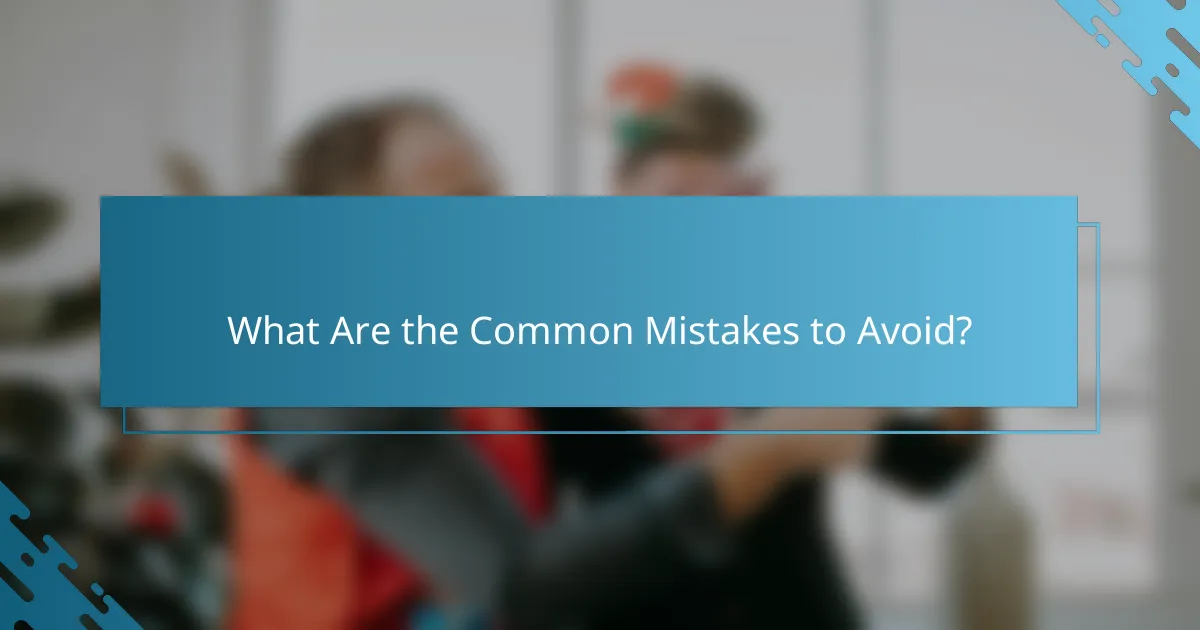
What Are the Common Mistakes to Avoid?
Common mistakes in DIY music promotion can hinder your success and waste your budget. Avoiding these pitfalls can significantly enhance your promotional efforts and engagement with your audience.
Ignoring Audience Engagement
Failing to engage with your audience can lead to missed opportunities for growth and connection. It’s essential to interact with fans through social media, respond to comments, and create content that resonates with them.
Consider hosting live Q&A sessions or using polls to gather feedback. This not only fosters a sense of community but also helps you understand what your audience wants, allowing you to tailor your promotions effectively.
Overlooking Analytics
Neglecting to analyze your promotional efforts can result in wasted resources and missed insights. Utilize tools like Google Analytics or social media insights to track engagement, reach, and conversion rates.
Regularly reviewing these metrics can help you identify what strategies are working and which need adjustment. For instance, if a particular platform drives more traffic, focus your efforts there to maximize your budget.
Neglecting Consistency
Inconsistent promotion can confuse your audience and weaken your brand presence. Establish a regular posting schedule across your platforms to maintain visibility and engagement.
Consider using content calendars to plan your posts in advance. This ensures that you consistently share updates, new releases, and promotional content, keeping your audience informed and engaged over time.

How Do I Choose the Right Platforms for Promotion?
Choosing the right platforms for music promotion involves understanding where your target audience spends their time and how they consume music. Focus on platforms that align with your genre and audience preferences to maximize your promotional efforts.
Identify Target Audience
Identifying your target audience is crucial for effective music promotion. Consider demographics such as age, location, and musical preferences to tailor your approach. For instance, younger audiences may gravitate towards platforms like TikTok and Instagram, while older listeners might prefer Facebook or Spotify.
Utilize tools like social media analytics and surveys to gather insights about your listeners. This data can help you create targeted campaigns that resonate with specific groups, increasing engagement and potential conversions.
Once you have a clear picture of your audience, prioritize platforms that best suit their habits. For example, if your audience is primarily in the U.S. and enjoys indie music, focusing on Spotify playlists and Bandcamp could be more effective than traditional radio promotion.
